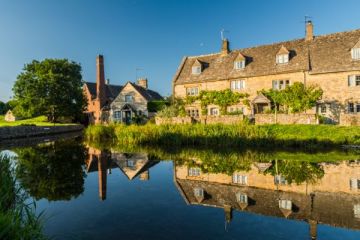
The Story Behind the Images - Cotswolds
The Cotswolds is a bit nebulous, and the term has been rather broadly - and incorrectly - applied to the area between Stratford-upon-Avon in the north to Bath in the south, and from the River Severn in the west to Oxford in the east. A more limited and precise description might be the area of the Cotswold escarpment, a line of limestone hills stretching from the outskirts of Bath to Broadway Tower in southern Worcestershire.
However you define it, the Cotswolds is a wonderfully scenic area of fields and stone walls, hidden valleys and green hills, with picturesque villages made of the golden-coloured oolitic limestone known as Cotswold stone. It is the locally-quarried stone that gives Cotswold cottages their wonderfully appealing golden colour.
Nowhere can you see this colour than at Bibury, a village on the River Coln known for Arlington Row, a terrace of 17th-century weavers' cottages now owned by the National Trust. Across the river is the ivy-clad Swan Inn, which frequently appears in calendars.
Not far from Bibury is the historic market town of Northleach, with its superb medieval church of St Peter and St Paul. Northleach church is a 'wool church', built in its current form by wealthy medieval wool merchants eager to put money back into their local villages - and eager to ensure their own passage to heaven by giving generously to the church.
A few miles from Northleach is Chedworth Roman Villa, one of the best-preserved Roman sites in Britain. If you head south from Chedworth towards Cirencester you are following the Roman road known as the Fosse Way. Cirencester itself was a prosperous Roman town and administrative centre, and you can still see evidence of a Roman amphitheatre on the edge of town.
The northern extremity of the Cotswold escarpment ends at Broadway Tower, a striking castellated folly that was once home to William Morris, one of the founders of the Pre-Raphaelite movement.
In the extreme south of the Cotswolds is Castle Combe, called by Morris the 'prettiest village in England'. No visitor's cars are allowed in Castle Combe, which helps maintain its air of timeless appeal. That appeal has long been recognised by film-makers and Castle Combe was a setting for the Rex Harison film 'Dr Doolittle' and more recently it appeared in the Steven Spielberg film 'Warhorse'.
The Cotswolds has wonderful market towns such as Tetbury - famous for its annual woolsack race - and Malmesbury with its partially ruined abbey.
But it is the villages that make the Cotswolds so special; places like Bourton-on-the-Water, known as the Venice of the Cotswolds for its series of picturesque footbridges over the peaceful River Windrush. Just outside Bourton-on-the-Water is Lower Slaughter, known for its attractive old mill - and more footbridges.
The Cotswolds has been our family home for over 14 years and I hope these photos will share just why we love the area so much.
Favourite Places to Photograph in the Cotswolds
- Broadway Tower
- Bibury and the River Coln
- Lower Slaughter
- Bourton-on-the-Water
- Castle Combe
Britain Express UK Image Shop
Our online shop offers canvas prints, framed prints, metal prints, acrylic prints, posters, iPhone cases, Galaxy cases, and greeting cards of UK scenes, specialising in historic sites and traditional locations around England, Scotland and Wales.
We've chosen Fine Art America to host our shop. FAA is the largest worldwide print-on-demand service and offers a wide variety of printed image products from 14 fulfilment centres in 5 different countries.
You can order in a wide variety of currencies (euros, Japenese yen, American, Canadian and Australian dollars), and products ship in 2-3 business days.
MORE PRINTS
- Arlington Row, Bibury, Gloucestershire
- Bourton-on-the-Water, Gloucestershire
- Castle Combe
- Lower Slaughter
- Lower Slaughter and the River Eye
- Northleach Church, Gloucestershire
- River Thames, Lechlade, Gloucestershire
- Stanton, Gloucestershire
- Thatched Cottage In Bagendon
- Thatched Cottage In Chipping Campden, Gloucestershire
- Upper Slaughter, Gloucestershire
- Winter Field, Little Rissington, Gloucestershire